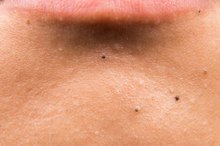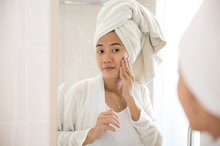What does fact checked mean?
At Healthfully, we strive to deliver objective content that is accurate and up-to-date. Our team periodically reviews articles in order to ensure content quality. The sources cited below consist of evidence from peer-reviewed journals, prominent medical organizations, academic associations, and government data.
The information contained on this site is for informational purposes only, and should not be used as a substitute for the advice of a professional health care provider. Please check with the appropriate physician regarding health questions and concerns. Although we strive to deliver accurate and up-to-date information, no guarantee to that effect is made.
How to Remove Facial Milia
Milia are small, white skin bumps that grow mostly on the face, around the eyes, cheeks, nose and chin. These benign cysts form when glands under the skin that normally help facilitate exfoliation fail to develop properly or are damaged, and dead skin cells become trapped. Although milia are not a form of acne, the condition is often referred to as “baby acne” because they appear on the faces of many newborns. But men and women of any age can develop milia. In infants, milia usually disappears on its own within a few weeks and should not be treated; in adults, the bumps are more persistent. If home treatments don’t work, you may need to see a dermatologist to remove milia.
Cleaning
Instead of soap or other cleaners, use acne face washes that contain salicylic acid or glycolic acid on areas where milia appear 2. You can purchase salicylic and glycolic acid products over the counter in a drugstore or cosmetic supply store, or get a stronger prescription product from your dermatologist 2. Follow directions for cleaning, and be careful not to get the wash in your eyes.
Although milia are not the same as acne or regular pimples, salicylic acid or glycolic acid can be used to help treat any skin condition that results from overgrowth of skin cells 2. These exfoliating cleansers help pull the plug from blocked pores on the skin so that milia shrink and disappear.
- Instead of soap or other cleaners, use acne face washes that contain salicylic acid or glycolic acid on areas where milia appear 2.
- Although milia are not the same as acne or regular pimples, salicylic acid or glycolic acid can be used to help treat any skin condition that results from overgrowth of skin cells 2.
Medication
How to Remove Milia Under Eyes
Learn More
Any medication that is used to treat acne can be used on milia, but it won’t necessarily have the same clearing effect. The products most recommended are those that have an exfoliating action on the skin. Many of the same ingredients used in medications for the skin are also used in skin washes. If you are routinely using an exfoliating face wash, the additional use of any of these products may cause excessively dry, flaky skin and may have to be discontinued.
Over-the-counter skin care products that contain alpha hydroxy acids (AHAs) and prescription-strength topical retinoids such as tretinoin and isotretinoin are acne medications that may be used to treat milia. Salicylic acid gels and creams can also help 2. Always use these medications according to package directions and keep them from coming in contact with your eyes. If over-the-counter products don’t help clear milia, talk to your doctor or dermatologist about prescription medications.
- Any medication that is used to treat acne can be used on milia, but it won’t necessarily have the same clearing effect.
- If over-the-counter products don’t help clear milia, talk to your doctor or dermatologist about prescription medications.
Extraction
Spa estheticians may be able to extract milia in the process of a deep-pore cleansing treatment. This type of facial may also be beneficial as a preventative treatment, if performed on a regular basis. Be sure the esthetician is licensed and has experience treating milia.
A dermatologist can extract milia by using a sterile lancing tool to pierce the bump and then squeezing out the contents with a comedone extractor or tweezers. It is not recommended that you do this at home. Milia will reappear if not removed completely.
- Spa estheticians may be able to extract milia in the process of a deep-pore cleansing treatment.
Related Articles
References
- MedlinePlus: Milia
- MedLinePlus: Salicylic Acid
- Yahya H. Idiopathic multiple eruptive milia: Report of a case in a Nigerian woman. Niger J Clin Pract. 2018;21(3):395-6. doi:10.4103/njcp.njcp_43_17
- Kutlubay Z, Tanakol A, Engýn B, et al. Newborn skin: common skin problems. Maedica (Buchar). 2017;12(1):42-7.
- Cho E, Cho SH, Lee JD. Idiopathic multiple eruptive milia occurred in unusual sites. Ann Dermatol. 2010;22(4):465-7. doi:10.5021/ad.2010.22.4.465
- Ghosh S, Sangal S. Congenital milia en plaque on scalp. Indian J Dermatol. 2015;60(1):105. doi:10.4103/0019-5154.147871
- Hinen HB, Gathings RM, Shuler M, Wine lee L. Successful treatment of facial milia in an infant with orofaciodigital syndrome type 1. Pediatr Dermatol. 2018;35(1):e88-e89. doi:10.1111/pde.13350
Writer Bio
Molly McAdams is a writer who lives in New York City. She has covered health and lifestyle for various print and online publishers since 1989. She holds a Master of Science degree in nutrition.








